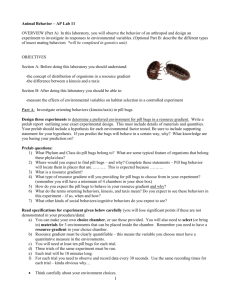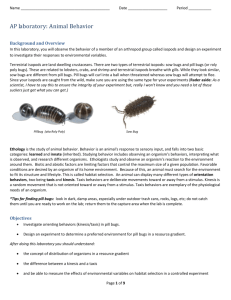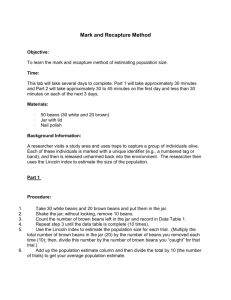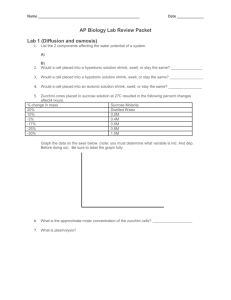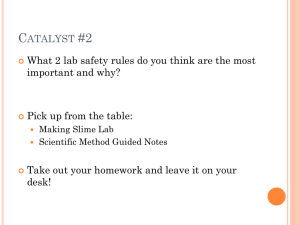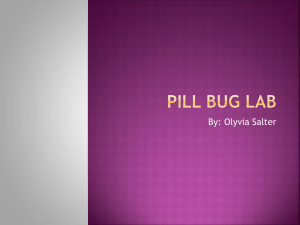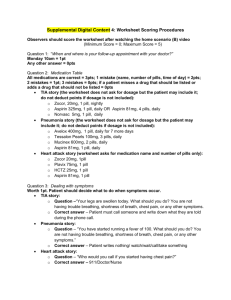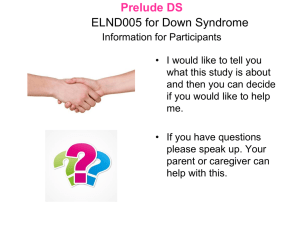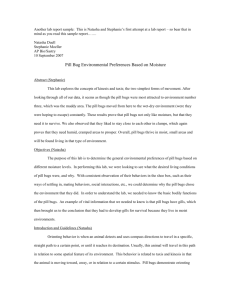AP Bio Lab – Animal Behavior
advertisement
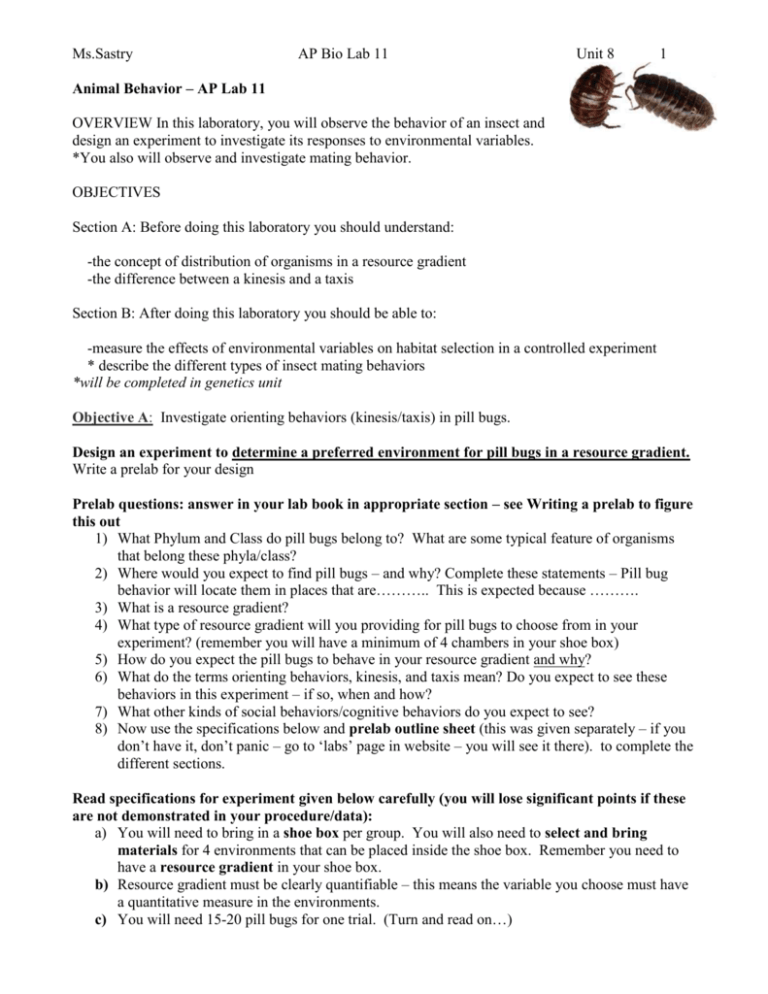
Ms.Sastry AP Bio Lab 11 Unit 8 1 Animal Behavior – AP Lab 11 OVERVIEW In this laboratory, you will observe the behavior of an insect and design an experiment to investigate its responses to environmental variables. *You also will observe and investigate mating behavior. OBJECTIVES Section A: Before doing this laboratory you should understand: -the concept of distribution of organisms in a resource gradient -the difference between a kinesis and a taxis Section B: After doing this laboratory you should be able to: -measure the effects of environmental variables on habitat selection in a controlled experiment * describe the different types of insect mating behaviors *will be completed in genetics unit Objective A: Investigate orienting behaviors (kinesis/taxis) in pill bugs. Design an experiment to determine a preferred environment for pill bugs in a resource gradient. Write a prelab for your design Prelab questions: answer in your lab book in appropriate section – see Writing a prelab to figure this out 1) What Phylum and Class do pill bugs belong to? What are some typical feature of organisms that belong these phyla/class? 2) Where would you expect to find pill bugs – and why? Complete these statements – Pill bug behavior will locate them in places that are……….. This is expected because ………. 3) What is a resource gradient? 4) What type of resource gradient will you providing for pill bugs to choose from in your experiment? (remember you will have a minimum of 4 chambers in your shoe box) 5) How do you expect the pill bugs to behave in your resource gradient and why? 6) What do the terms orienting behaviors, kinesis, and taxis mean? Do you expect to see these behaviors in this experiment – if so, when and how? 7) What other kinds of social behaviors/cognitive behaviors do you expect to see? 8) Now use the specifications below and prelab outline sheet (this was given separately – if you don’t have it, don’t panic – go to ‘labs’ page in website – you will see it there). to complete the different sections. Read specifications for experiment given below carefully (you will lose significant points if these are not demonstrated in your procedure/data): a) You will need to bring in a shoe box per group. You will also need to select and bring materials for 4 environments that can be placed inside the shoe box. Remember you need to have a resource gradient in your shoe box. b) Resource gradient must be clearly quantifiable – this means the variable you choose must have a quantitative measure in the environments. c) You will need 15-20 pill bugs for one trial. (Turn and read on…) Ms.Sastry AP Bio Lab 11 Unit 8 2 d) Three trials of the same experiment must be run. e) Each trial will be 30 minutes long. f) For each trial you need to have at least 6 data collection times – so observe and record at least every 5 min. Use the same recording times for each trial – kinda obvious why… g) You need to include a 24 hour data point in your experiment – leave the box undisturbed and come back and check the next day – you may make additional recordings if you so desire. Think carefully about your environment choices. Bring your own pill bugs!!! Brainstorm and draw your design here: Ms.Sastry AP Bio Lab 11 Unit 8 3 Lab report instructions Please do not answer these questions one after another as though the report was a series of answers. Integrate and weave these answers into YOUR introduction based on YOUR research on this topic. Points will be taken off if you document answers one after the other – if you don’t know how to do this – please see the samples posted in the ‘labs’ page of the website. Guideline questions for introduction section: (apart from your own background research) – remember your prelab has a lot of the answers! Base your Introduction on internet research – read up and rephrase in your own words. 1) What Phylum and Class do pill bugs belong to? What are some typical feature of organisms that belong these phyla/class – try to relate characteristics that may impact this lab? 2) Where would you expect to find pill bugs? 3) What are orienting behaviors? 4) Why are they important? 5) Identify and describe the different orienting behaviors (include kinesis/taxis) that pills bugs demonstrate in nature. 6) Why do the pill bugs exhibit such orienting behavior – relate it to specific body structures/functions. ( that is same as - what are the proximate and ultimate causes of orienting behaviors in pill bugs? ) 7) What is a resource gradient? 8) What type of resource gradient will you providing for pill bugs to choose from in your experiment? How do you expect the pill bugs to behave in your resource gradient and why? 9) How does your resource gradient – or ingredient/s in your resource gradient relate to an environmental factor in the pill bugs natural environment; why would orienting behavior demonstrated in your shoebox be of any value to the pill bug in its natural environment? 10) Describe briefly what you will do in this lab – give the principles of the design –how you set it up to reduce experimental errors. 11) Do this as a separate subsection. How many AP themes does this lab connect to – state them (see home page in website if you don’t know the themes). Provide a reference for ALL material that is not your original thought – see lab report format sheet for how to reference Biology citations. Answer ALL guideline questons ‘IN CONTEXT’ and not listed one below the other. Results (if you follow my tutorial – you should satisfy all these requirements except for the highlighted one) - Raw data presented in well organized tables with headings - Raw data units present - Raw data needs to be analyzed statistically using MS Excel/software – averages, standard errors calculated; t test or statistical analysis for significance performed - Analyzed/summated data must be recorded in separate tables - Qualitative data (personal observations) must accompany quantitative data whenever possible - Insert your charts/tables into the word documents. -Choose correct intervals for your axes so data is ‘squished’ or data points lie outside the axes. Ms.Sastry AP Bio Lab 11 Unit 8 -Be sure to include a title, labels on the axes, and the units of measurement on all graphs. -Show ALL calculations 4 Conclusion and Discussion – in paragraph form 1) SUMMARIZE your results in clear statements free from opinions – don’t recount in words a long list of data points recorded, but integrate and make inferences from your data - what you can generalize from your results? Conclusion statements must include evidences from your results. Example; We were able to conclude that teens are not significantly affected by caffeine intake on their test performance because 78% of the teens assessed did not show a marked deviation in their AP Bio tests compared to placebo controls (pl. refer to table 2, page 5 in report). Use t test results to make claims about differences in between groups that takes into account the standard error bars overlapping. 2) Explicitly state what additional trends and relations can be noted between your independent and dependent variables in statement form – use your graphs as the basis and not your opinions. Ex: We noted that there was a trend for students to perform poorly (set at <20% of average) in the second half of the test with caffeine intake of more than 600 gms. This conclusion is based on the observation that 90% of these high caffeine group members received a score of 60% or less in the second half of the test (see table ….) 3) Is your data reliable – based on sample size and number of trials you ran. How can you make it better? Did you run controls for your experiment? Did you have one independent variable? If not, how are you able to make any conclusions about the preferred pill bug environment? 4) Discuss deviations from the expected result/hypothesis – provide scientific explanations based on internet research for these deviations – make sure these are not opinion based 5) Why did you obtain the results you observed - Give a physiological explanation (based on their body structure- function relationship) for ALL results expected or otherwise! -Answer guideline questions in general context of discussion (not as separate test answers again) Guideline questions to answer in discussion section: 1) Is the pill bug behavior best classified as kinesis or taxis? Why? 2) Did you see any other types of behavior during this experiment – describe them and their benefit to the pill bug?
